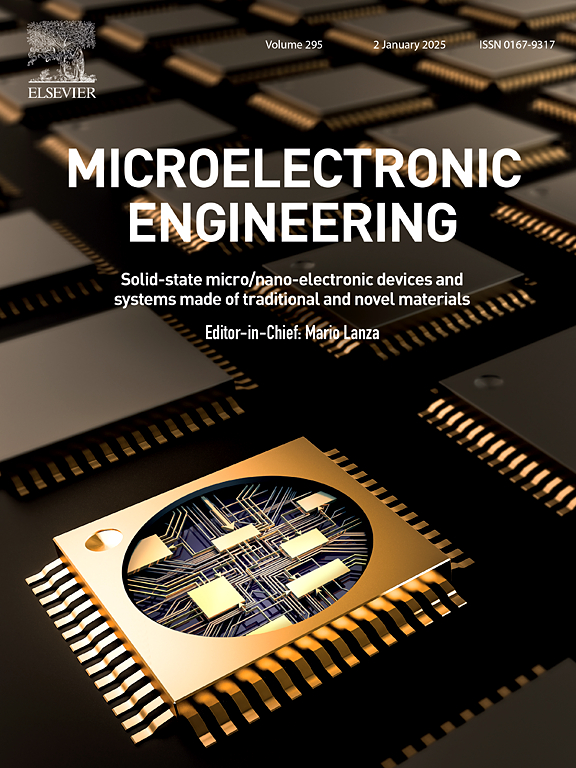Amorphous indium gallium zinc oxide thin film transistors (a-IGZO-TFTs): Exciting prospects and fabrication challenges
IF 3.1
4区 工程技术
Q2 ENGINEERING, ELECTRICAL & ELECTRONIC
引用次数: 0
Abstract
In today's consumer electronics market, major manufacturing companies may be profitable and scalable thanks to technologies like thin-film transistors (TFTs). TFTs are found in TVs, smartphones, laptops, brain-like synaptic transistors, back-planes in CMOS image sensors, integrated circuits (ICs), flexible & wearable electronics, power switching circuits, back-end-of-line (BEOL) transistor elements in 3D-logic and cell transistors in dynamic random-access memory (DRAM). They have also been proposed as a potential solution for flexible CPUs. A high mobility of 74.4 cm2/Vs and ION/IOFF of 3.39 × 109 and a VON of less than ±0.1 V and a SS of less than 0.1 V/dec were achieved in a-IGZO based TFTs. Numerous efforts have been made to enhance the a-IGZO TFTs' electrical characteristics by optimizing the fabrication process. Numerous studies have also addressed the instability problems, such as the a-IGZO devices' hot-carrier effects, self-heating, and charge-trapping. TFTs with a-IGZO are being extensively studied adopting the a vertical-channel approach in order to be used in 3-D electronic devices. This article reviews the recent developments in materials and architectures, performance overview of IGZO-TFTs, advances and challenges in fabrication technologies and reliability issues & degradation mechanisms of IGZO-TFTs.
非晶铟镓氧化锌薄膜晶体管(a-IGZO-TFTs):令人兴奋的前景和制造挑战
在今天的消费电子市场上,由于薄膜晶体管(tft)等技术,大型制造公司可能会盈利并可扩展。tft广泛应用于电视、智能手机、笔记本电脑、类脑突触晶体管、CMOS图像传感器背板、集成电路(ic)、柔性电子放大器等领域。可穿戴电子产品,电源开关电路,3d逻辑中的后端(BEOL)晶体管元件和动态随机存取存储器(DRAM)中的单元晶体管。它们也被提议作为灵活cpu的潜在解决方案。在基于A - igzo的TFTs中获得了74.4 cm2/Vs的高迁移率和3.39 × 109的离子/离合比,VON小于±0.1 V和SS小于0.1 V/dec。通过优化制造工艺来提高a-IGZO tft的电学特性已经做了大量的努力。许多研究也解决了不稳定性问题,如a-IGZO器件的热载子效应、自加热和电荷捕获。为了在三维电子器件中应用,采用垂直通道方法对具有a- igzo的tft进行了广泛的研究。本文综述了材料和结构的最新发展,igzo - tft的性能概述,制造技术的进步和挑战以及可靠性问题。igzo - tft的降解机制。
本文章由计算机程序翻译,如有差异,请以英文原文为准。
求助全文
约1分钟内获得全文
求助全文
来源期刊

Microelectronic Engineering
工程技术-工程:电子与电气
CiteScore
5.30
自引率
4.30%
发文量
131
审稿时长
29 days
期刊介绍:
Microelectronic Engineering is the premier nanoprocessing, and nanotechnology journal focusing on fabrication of electronic, photonic, bioelectronic, electromechanic and fluidic devices and systems, and their applications in the broad areas of electronics, photonics, energy, life sciences, and environment. It covers also the expanding interdisciplinary field of "more than Moore" and "beyond Moore" integrated nanoelectronics / photonics and micro-/nano-/bio-systems. Through its unique mixture of peer-reviewed articles, reviews, accelerated publications, short and Technical notes, and the latest research news on key developments, Microelectronic Engineering provides comprehensive coverage of this exciting, interdisciplinary and dynamic new field for researchers in academia and professionals in industry.
 求助内容:
求助内容: 应助结果提醒方式:
应助结果提醒方式:


